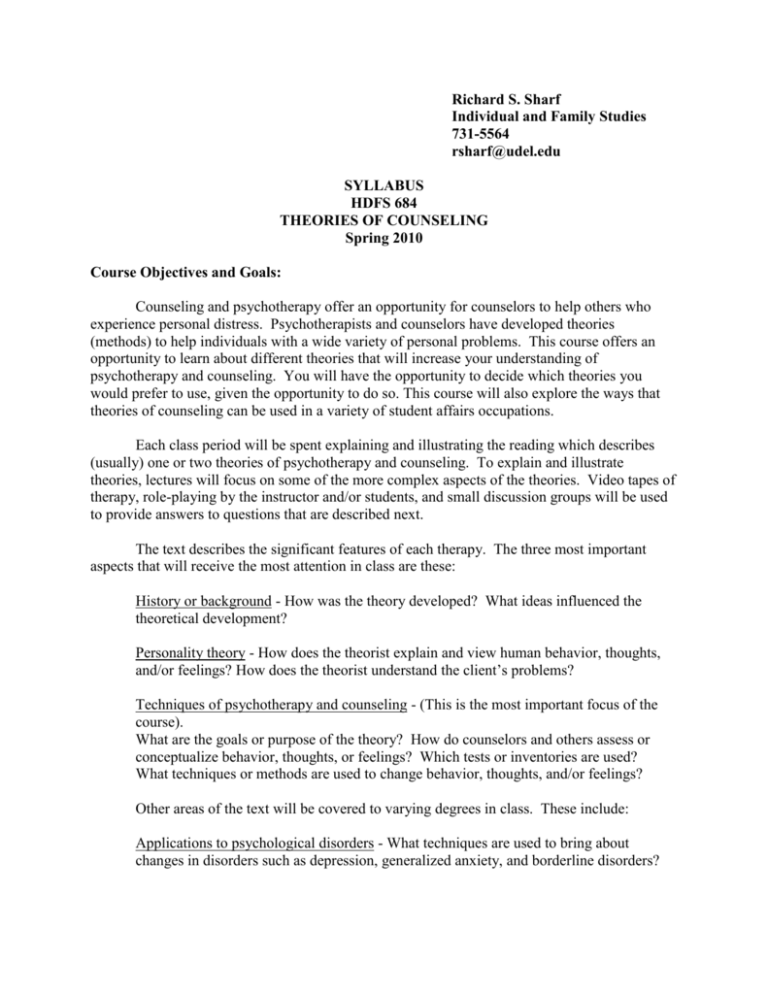Theories of Counseling
advertisement

Richard S. Sharf Individual and Family Studies 731-5564 rsharf@udel.edu SYLLABUS HDFS 684 THEORIES OF COUNSELING Spring 2010 Course Objectives and Goals: Counseling and psychotherapy offer an opportunity for counselors to help others who experience personal distress. Psychotherapists and counselors have developed theories (methods) to help individuals with a wide variety of personal problems. This course offers an opportunity to learn about different theories that will increase your understanding of psychotherapy and counseling. You will have the opportunity to decide which theories you would prefer to use, given the opportunity to do so. This course will also explore the ways that theories of counseling can be used in a variety of student affairs occupations. Each class period will be spent explaining and illustrating the reading which describes (usually) one or two theories of psychotherapy and counseling. To explain and illustrate theories, lectures will focus on some of the more complex aspects of the theories. Video tapes of therapy, role-playing by the instructor and/or students, and small discussion groups will be used to provide answers to questions that are described next. The text describes the significant features of each therapy. The three most important aspects that will receive the most attention in class are these: History or background - How was the theory developed? What ideas influenced the theoretical development? Personality theory - How does the theorist explain and view human behavior, thoughts, and/or feelings? How does the theorist understand the client’s problems? Techniques of psychotherapy and counseling - (This is the most important focus of the course). What are the goals or purpose of the theory? How do counselors and others assess or conceptualize behavior, thoughts, or feelings? Which tests or inventories are used? What techniques or methods are used to change behavior, thoughts, and/or feelings? Other areas of the text will be covered to varying degrees in class. These include: Applications to psychological disorders - What techniques are used to bring about changes in disorders such as depression, generalized anxiety, and borderline disorders? HDFS 684 Spring 2010 Page 2 Brief psychotherapy - How can the therapy be done more quickly, or more efficiently? Current trends - How is the theory changing in its techniques and training methods? Using the theory with other theories - How flexible is the theory? How can its techniques be combined with those from another theory? How do integrative therapists use theories? Research - How well can the effectiveness of therapeutic change be tested? What types of research have been done and what are their findings? (This will be covered very briefly, and sometimes not at all.) Gender issues - How does the theory view men and women differently? How does the therapy address special concerns of women? Multicultural issues - What cultural values are implicit in the theory? How does the theory attend to the concerns of individuals from different cultures? Group counseling - How can the theories and their techniques be applied to group therapy? Summary of Learning Objectives By learning concepts that explain answers to these questions, students should be able to explain how counseling and psychotherapy are done by different theorists. The concepts that are most important in the course are those that explain personality theory and techniques to change behavior, thoughts or feelings. By learning information about each of the topics for theories covered in this course (as described below in the syllabus), students should be able to do well on multiple choice examinations for the course as well as on certification and licensure multiple choice examinations, February 9 Introduction Introduction - To the course Counseling and psychotherapy - The same or different? Theories - How are they constructed? Why are they useful? Psychological disorders - Depression, anxiety, borderline, and other disorders. Ethics HDFS 684 Spring 2010 Page 3 February 16 Psychoanalysis Sigmund Freud stressed the importance of inborn drives (particularly sexual) in determining later personality development. Others who followed him emphasized the importance of the adaptation to the environment, early relationships between child and mother, and developmental changes in being absorbed with oneself at the expense of meaningful relationships with others. Recent writings emphasize the relationship between patient and therapist. All of these views of development make use of Freud's concepts of unconscious processes (portions of mental functioning that we are not aware of) and, in general, his structure of personality (ego, id, superego). Traditional psychoanalytic methods require several years of treatment. Because of this, moderate length and brief therapy methods that use more direct, rather than indirect, techniques have been developed. Chapter 1. Chapter 1. Chapter 2. Chapter 2. February 23 Introduction, 1-24. Student Manual, 1-13. Psychoanalysis, 25-74. Student Manual, 14-37. Existential Psychotherapy A philosophical approach to people and problems relating to being human or existing, existential psychotherapy deals with life themes rather than techniques. Such themes include living and dying, freedom, responsibility to self and others, finding meaning in life, and dealing with a sense of meaninglessness. Becoming aware of oneself and developing the ability to look beyond immediate problems and daily events to deal with existential themes is a goal of therapy, along with developing honest and intimate relationships with others. Although some techniques have been developed, the emphasis is on issues and themes, not method. Chapter 5. Chapter 5. Existential therapy, 146-186. Student Manual, 73-89. HDFS 684 Spring 2010 Page 4 March 2 Person-Centered Therapy In his therapeutic work, Carl Rogers emphasized understanding and caring for the client, as opposed to diagnosis, advice, or persuasion. Therapeutic genuineness, through verbal and nonverbal behavior, and unconditionally accepting clients for who they are is characteristic of Rogers's approach to therapy. Personcentered therapists are concerned about understanding the client's experience and communicating their understanding to the client so that an atmosphere of trust can be developed that will foster change on the part of the client. Clients are given responsibility for making positive changes in their lives. Chapter 6. Chapter 6. March 9 Person-centered therapy, 187-218. Student Manual, 90-106. Gestalt Therapy Developed by Fritz Perls, gestalt therapy helps the individual to become more aware of self and others. Emphasis is on both bodily and psychological awareness. Therapeutic approaches deal with being responsible for oneself, being attuned to one's language, nonverbal behaviors, emotional feelings, and conflicts within oneself and with others. Therapeutic techniques include the development of creative experiments and exercises to facilitate self-awareness. Chapter 7. Chapter 7. March 16 Gestalt therapy, 219-255. Student Manual, 107-121. Adlerian Psychotherapy Alfred Adler believed that the personality of individuals was formed in their early years as a result of relationships within the family. He emphasized the importance of individuals' contributions to their community and to society. The Adlerian approach to therapy is practical, helping individuals to change dysfunctional beliefs and encouraging them to take new steps to change their lives. An emphasis on teaching and educating individuals and families about dealing with interpersonal problems is characteristic of Adlerian therapy. HDFS 684 Spring 2010 Page 5 Chapter 4. Chapter 4. Adlerian therapy and counseling, 112-145. Student Manual, 55-72. March 23 Mid Term Exam March 30 Spring Break April 6 Behavior Therapy Based on scientific principles of behavior, such as classical and operant conditioning, as well as observational learning, behavior therapy applies principles of learning such as reinforcement, extinction, shaping of behavior, and modeling to help a wide variety of clients with different problems. Emphasis is on precision and detail in evaluating psychological concerns and then assigning treatment methods that may include relaxation, exposure to a feared object, copying a behavior, or role-playing. Chapter 8. Chapter 8. April 13 Behavior therapy, 256-299. Student Manual, 122-137. Rational Emotive Behavior Therapy Developed by Albert Ellis, rational emotive behavior therapy (REBT) focuses on irrational beliefs that individuals develop that lead to problems related to emotions (for example fears and anxieties) and to behaviors (such as avoiding social interactions or giving speeches). Although REBT uses a wide variety of techniques, the most common method is to dispute irrational beliefs and to teach clients to challenge their own irrational beliefs so that they can reduce anxiety and develop a full range of ways to interact with others. Chapter 9. Chapter 9. April 20 Rational emotive behavior therapy, 300-333. Student Manual, 138-153. Cognitive Therapy Belief systems and thinking are seen as important in determining and affecting behavior and feelings. Aaron Beck developed an approach which helps individuals understand their own HDFS 684 Spring 2010 Page 6 maladaptive thinking and how it may affect their feelings and actions. Cognitive therapists use a structured method to help their clients understand their own belief systems. By asking clients to record dysfunctional thoughts and using questionnaires to determine maladaptive thinking, cognitive therapists are then able to make use of a wide variety of techniques to change beliefs that interfere with successful functioning. They also make use of affective and behavioral strategies. Chapter 10. Chapter 10. April 27 Cognitive therapy, 334-373. Student Manual, 154-166. Reality Therapy Reality therapists assume that individuals are responsible for their own lives and for taking control over what they do, feel, and think. Developed by William Glasser, reality therapy uses a specific process to change behavior. A relationship is developed with clients so that they will commit to the therapeutic process. Emphasis is on changing behaviors that will lead to modifications in thinking and feeling. Making plans and sticking to them to bring about change while taking responsibility for oneself is an important aspect of reality therapy. Chapter 11. Chapter 11. May 4 Reality therapy, 374-407. Student Manual, 167-182. Constructivist Approaches Constructivist approaches attend to the client’s way of viewing problems and situations. There are two types of constructivist approaches discussed in this chapter: solution – focused therapy and narrative therapy. Neither therapy uses a theory of development or personality to deal with the clients’ problems. It is the client who presents an issue needing a solution, and the therapist that concentrates on solutions to the problem. Solution – focused therapy finds new solutions to a problem; it does not focus on the origin of the problem. Narrative therapy examines patients’ stories, learning the patients’ views of their lives. Narrative therapists try to help patients change stories with problems to stories with more positive outcomes. Both therapies are brief and use creative techniques to bring about change. HDFS 684 Spring 2010 Page 7 Chapter 12. Chapter 12. Constructivist approaches 408-434. Student Manual, 183-197. Feminist Therapy: A Multicultural Approach Rather than focusing only on the individuals' psychological problems, feminist therapists emphasize the role of society in creating problems for individuals. Particularly, they are concerned about gender-roles and power differences between men and women, as well as cultural issues. They have examined different ways that men and women develop throughout the lifespan (including social and sexual development, child raising practices, and work roles). Differences in moral decision making, relating to others, and roles in abuse and violence are issues of feminist therapists. By combining feminist therapy with other theories, feminist therapists take a sociological as well as a psychological view that focuses, not only on gender, but also on multicultural issues. Among the techniques that they use are those that help individuals address culture, gender and power inequalities by not only changing client behavior, but also by changing societal groups or institutions. Chapter 13. Chapter 13. May 11 Feminist therapy: A multicultural approach, 435477. Student Manual, 198-215. Family Therapy Family systems therapy is a specific type of family therapy. Whereas other theories focus on the problems of individuals, family systems therapists attend to interactions between family members, viewing the entire family as a single unit or system. Treatment is designed to bring about change in the functioning and relationships within the family rather than within a single individual. Several different approaches to family systems therapy have been developed. Some focus on the impact of the parents' own families, others on how family members relate to each other in the therapy hour, and yet others focus on changing symptoms. Ways of applying other theories in this book to family therapy are also shown. Chapter 14. Family therapy, 478-520. HDFS 684 Spring 2010 Page 8 Chapter 14. Student Manual, 216-234. Integrative Approaches This chapter describes three of the most common integrative therapies. The therapies combine different theories of personality as well as theories of psychotherapy. Prochaska’s transtheoretical approach selects concepts and techniques from many different theories to make its own psychotherapeutic approach. Wachtel’s cyclical psychodynamics combines the personality theory concepts and techniques of psychoanalysis and behavior therapy, as well as a few other therapies. Lazarus’s multimodal therapy uses a social learning view of personality theory and selects from many other theories for its psychotherapeutic techniques. Integrative therapies provide a way of combining many of the theories that have been described in other chapters in this text. Chapter 16. Chapter 16. Integrative Approaches, 564-585. Student Manual, 252-264. May 18 Other Approaches Five different psychotherapies are treated briefly in this chapter. Asian therapies often emphasize quiet reflection and personal responsibility to others. Body therapies work with the interaction between psychological and physiological functioning. Psychodrama is an active system where clients, along with group and audience members, play out roles related to their problems while therapists take responsibility for directing the activities. Interpersonal therapy consists of specific techniques developed for the brief treatment of depression using three phases. Creative arts therapies include art, dance movement, drama, and music to encourage expressive action and therapeutic change. Chapter 15. Chapter 15. Other approaches, 521-563. Student Manual, 235-251. HDFS 684 Spring 2010 Page 9 Comparison and Critique Each theory is compared with each other for each of the major topics that are listed in the objectives section. Strengths and weaknesses of each theory are presented. Critiquing is done from several points of view. Chapter 17. Chapter 17. To Be Announced Comparison and critique, 585-615. Student Manual, 265-288. Final Exam Office hours: Call me at 731-5564, e-mail me at rsharf@udel.edu, or see me after class to make arrangements to meet me. I would be pleased to meet with you individually, if you wish. Texts: Sharf, R. S. (2008). Theories of Psychotherapy and Counseling: Concepts and Cases. (4th ed.). Belmont, CA: Brooks/Cole. Sharf, R. S. (2008). Theories of Psychotherapy and Counseling: Concepts and Cases. Student Manual. (4th ed). Belmont, CA: Brooks/Cole. HDFS 684 Spring 2010 Page 10 CourseRequirements: 1. Weekly readings from the text, student manual, class attendance, and participation are all required. 2. Paper: Using Counseling Theory to Conceptualize a Psychological Concern Section 1: Use one psychoanalytic personality theory concept (preferably a defense mechanism) to conceptualize a problem that you have encountered when dealing with a student (preferably on your assistantship, but it could be as an undergraduate, or as a friend). Describe the situation. Explain how the concept applies. Do not discuss techniques. Do not explain the psychoanalytic concept, but use it to understand the person’s situation. You may use other psychoanalytic concepts in your discussion if appropriate. Section 2: Use one existential personality theory concept to conceptualize a problem that you have encountered when dealing with a student (preferably on your assistantship, but it could be as an undergraduate, or as a friend). Describe the situation. Explain how the concept applies. Do not discuss techniques. Do not explain the existential concept, but use it to understand the person. You may use other existential concepts in your discussion if appropriate. The paper should consist of two separate sections which I will grade separately. The two examples can be from two different individuals. Each section should be one to two pages long. (100 points) Due March 2, 2009. 3. Mid-term exam (100 points) March 23, 2009. 4. Paper on your theory of counseling. Describe which theories of counseling you would like to use if you were a counselor (not another student affairs position). Give your rationale for this choice. Explain how you would apply your theory of counseling to depression or anxiety (not both). Select two or three theories and describe how you would use them together. (Wachtel’s cyclical model can be a guide for using two or three theories together; you don’t need to use the ones he uses).The paper should be about four or five double spaced pages. (100 points) May 18, 2009. 5. Final exam. (100 points) To be announced. HDFS 684 Spring 2010 Page 11 Grading: A = 400 - 373 A- = 372 - 360 B+ = 359 - 347 B = 346 - 333 B- = 332 - 320 C+ = 319 - 306 C = 305 - 293 C- = 292 - 280 D or F = 279 - 0








